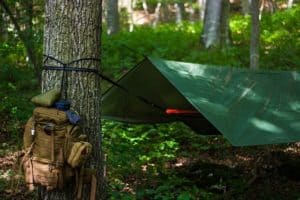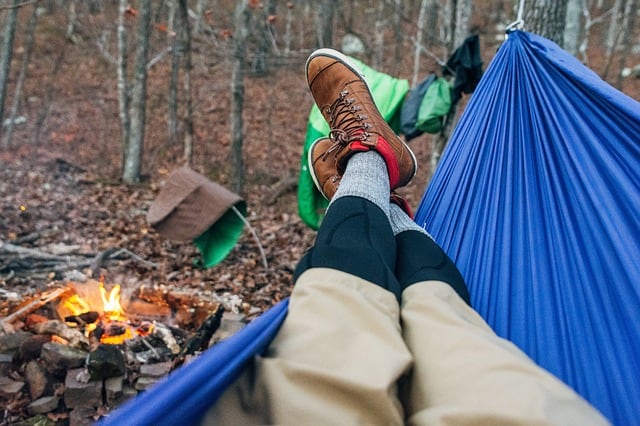If your new to hammock camping one of your primary concerns might be how safe is it to hammock camp. I have to admit when I first started hammock camping I had the same concern.
In this article, I will go over everything I learned about hammock camping safety and some best practices to keep you out of danger.
So first things first is hammock camping safe? Yes, hammock camping is safe as long as your hammock is set up properly and a few basic precautions are taken. In fact, in some instances, hammock camping can actually be safer than traditional tent-style camping.
Now that we know hammock camping can be safe with the proper setup and precautions. Let’s go into detail about how to exactly set up your hammock for camping and what precautions you should take to stay safe while hammock camping.
Proper Hammock Camping Set Up to Stay Safe While Hammock Camping
When you are setting up your camping hammock there are several key things to remember and pay attention to when setting up your hammock outlined below.
Use Quality Gear and Inspect Before Each Use
While you will find many cheap camping hammocks on the market we recommend purchasing a quality hammock and gear in order to stay safe while camping. After all, do you really want to use inferior and cheap equipment while you are hanging in the air?
One of our favorite quality camping hammocks currently on Amazon is the Easthills Outdoor Jungle Explorer Camping Hammock which you can check out on Amazon here.
The next thing to remember is it is always important to inspect your hammock and gear before each use. Even the most quality of equipment and gear can wear over time which can create weak points in your hammock camping setup.
Items to pay particular attention to are the ropes, straps, guy lines, carabiners, and any connectors or stitching holding the various parts of the camping hammock together as they are often the first places to fail.
Choose a Safe Location to Hang Your Hammock
The next item to keep in mind is your camping hammock is only as safe as the place you choose to hang it. I few specific things to remember when choosing a location for your camping hammock are:
- Always make sure your anchor points are attached to a sturdy and strong structure.
- If you’re attaching your camping hammock to trees make sure the trees are healthy and alive. Never attach your camping hammock to a dead tree.
- Don’t forget to look up when choosing a location make sure there are no dead branches or limbs that could potentially fall on you in the middle of the night without warning.
- Make sure you’re not near up any trees or other obstacles as you want to have room for your hammock to sway from side to side without hitting anything.
- Mount your camping hammock a safe distance from the ground in case there is a failure in the hammock to prevent severe injury.
Tree Straps. What Are They and Why You Need Them?
While in a pinch you can use rope or paracord in order to attach your hammock to trees while camping it’s better in the long term to invest in a quality pair of tree straps.
As rope has a tendency to stretch and weaken over time not to mention it can damage and harm trees by gauging and stripping away their protective bark layer.
Tree straps are just what they sound like they are heavy-duty straps made from strong and rugged material that can hold large loads with multiple loops in order to provide just the right length no matter the situation.
The best tree straps we could find on Amazon right now for hammock camping is the Foxelli XL Hammock Straps which you can check out on Amazon by clicking here.

Your Sleeping Outdoors so be Prepared
When the conditions are just right there is nothing better than sleeping in your hammock in the open air with nothing between you and the open sky above allowing you to gaze at the stars as you fall asleep at night.
But the fact of the matter is in most cases open-air sleeping will not be possible due to a myriad of reasons such as rain or thunderstorms, cold weather, bugs, and pests, etc… So it’s important to be prepared for all types of potential conditions.
So when hammock camping make sure to have and pack your rain fly and cold-weather gear when appropriate to keep you dry and warm while in your hammock. Also, don’t forget the bug net in order to keep those pesky bugs away while you are sleeping at night.
Insulate, Insulate, Insulate
When camping in warm weather camping hammocks are a great option because they tend to keep you about 5 to 10 degrees cooler when sleeping at night due to your elevated sleeping position allowing airflow underneath and around you.
In cold weather climates though this elevated sleeping position can actually work against you. This is because when sleeping in a traditional tent the ground actually acts as an insulator to keep you warmer at night.
However, when sleeping in a camping hammock you lose this insulator causing you to be colder at night.
Luckily though there is a solution which is to use an under quilt or insulating barrier at the bottom of your hammock.
Without an insulating barrier at the bottom of your hammock, your bareback will be pressed up against the thin hammock material which provides no insulating protection from the cold air. Causing you to lose a lot of body heat and make you colder overall.
So when camping in colder climates when the air temperature is going to be below 70 degrees at night its best to have some sort of insulating barrier at the bottom of your hammock. Which can include an under quilt which actually hangs below your hammock, or a sleeping pad, yoga mat or thick wool blanket that lays in the bottom of your hammock.
One other piece of gear that can keep you warmer when camping in cold weather is a rain fly. While we all know the primary purpose of a rain fly is to keep you dry in the rain it also does a great job of trapping the warmth from your body heat providing an insulated pocket of warmer air above you.
Just make sure you are installing the rain fly close enough to your hammock to benefit from this.
Camp With A Buddy or Have a Check-In Schedule
When hammock camping or any other type of camping its always best to camp with a buddy as there is always safety in numbers.
So if you are planning to go hammock camping its always best to go camping with someone else in case something happens.
If however, you choose to go hammock camping solo make sure you set up a regular check-in schedule with someone at pre-designated times so that if you miss a check-in time someone knows to check on you or come looking for you.
Also. it’s always a good idea to make sure that when you’re going camping that someone knows where you’re going to be. That way in case there is some sort of an emergency or issue they know exactly where to go looking for you.
Additional Precautions to Take When Hammock Camping to Stay Safe
- When tent camping all of your gear is usually inside the tent with you protected from the elements such as rain, snakes, rodents, and spiders but when hammock camping your gear will typically be outside so make sure you take precautions to protect your gear outside the hammock.
- When hammock camping it’s never a bad idea to have a few backups of your critical camping hammock components in case of failures such as a spare carabiner or tree strap.
- Finally when hammock camping make sure to have a few small repair items with you to make basic repairs in the field in case the need arises such as a needle and thread or a roll of duct tape.
Looking for even more information on hammock camping check out this really helpful video I found on hammock camping.

